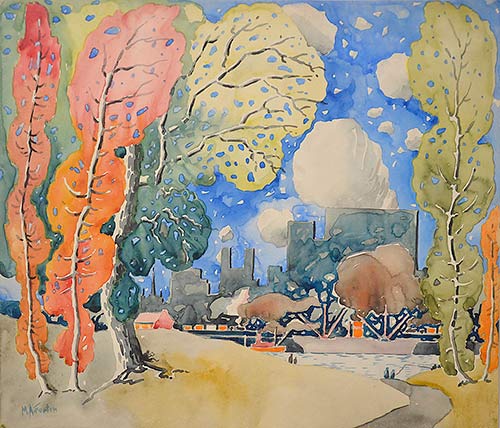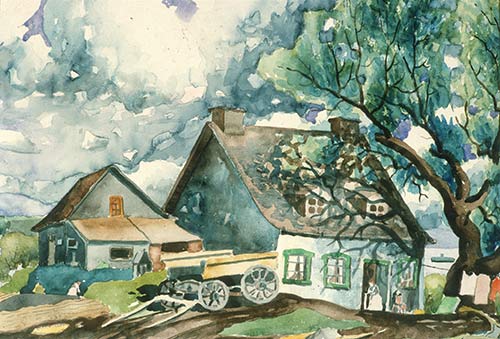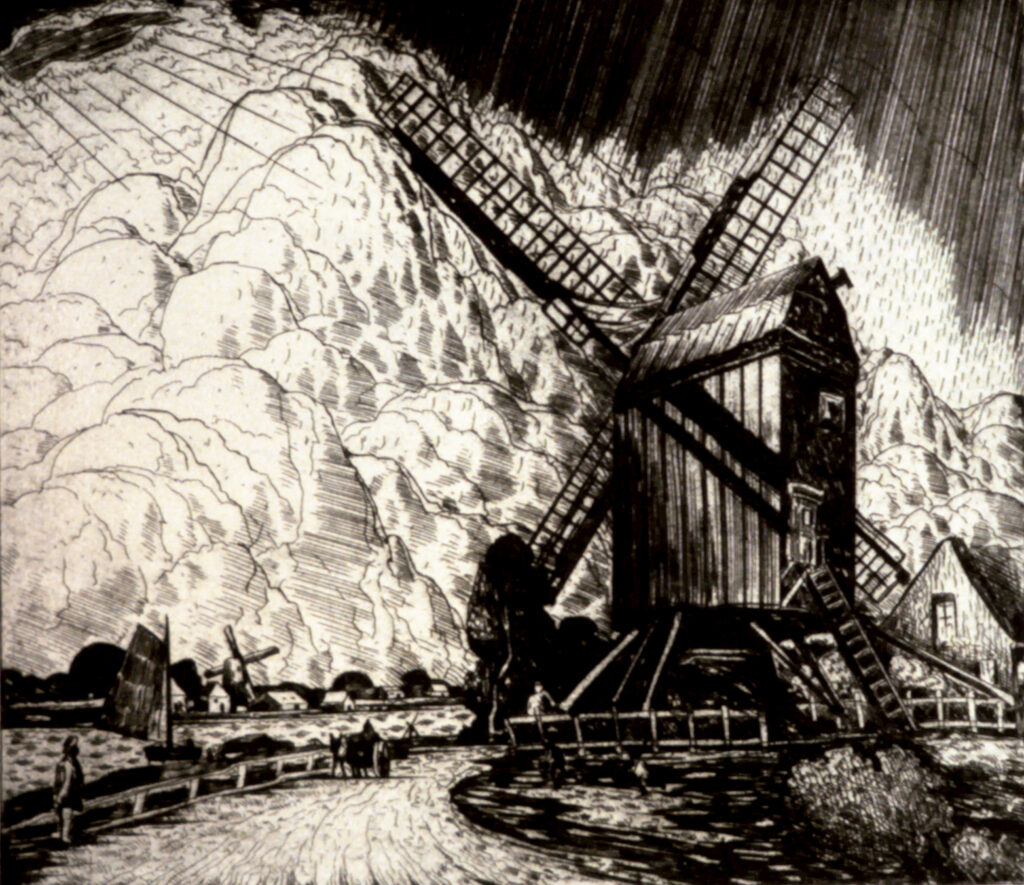Over a period of more than 50 years, Fortin produced a considerable number of works. From his beginnings, where he tries to paint still life as he was taught at school, to his last works in which he paints from memory and makes a synthesis of the Quebec rural landscape that ranges in many variations, Fortin will produce more than 5000 studies, drawings, paintings and other works.
To sort out this abundant production, we often group his works according to the technique used by the artist, because throughout his career, not only did Fortin best utilizes various mediums and supports, but he moreover tried to renew his way of working with them. Thus, about his watercolors, his biographers often speak of his sponge watercolors (sponge trees), his pure watercolors or his mixed watercolors. As for the oils, they are classified according to whether they belong to his large trees, his black backgrounds (black manner) or his grey backgrounds (grey manner). While many of the remaining works can be grouped according to the other mediums he used, i.e., casein, pastel, and engraving, it is nevertheless important to note that these categories do not cover all of Fortin’s production. They omit in fact to include his early works, many of his late works, a number of studies, some drawings, watercolors halfway between his mixed and pure techniques, numerous oils that are neither large trees nor works on black or gray backgrounds, as well as many other unclassifiable creations.

Arbres d’automne, vers 1925,
aquarelle et pastel sur papier, 35,6 x 55,9 cm,
coll. privée (F00978)

L’automne, avant 1928,
aquarelle et pastel sur papier, 56 x 71 cm,
coll. privée (F00272)

Automne à l’île Sainte-Hélène, entre 1920 et 1930,
aquarelle et pastel sur papier,
45 x 51 cm (F00107)
“In watercolor, you don’t control your brush. In oil, you are sure of your brush. […] Watercolor is calculation! A shade of cobalt, of madder, you throw that on your paper, and it’s only after 25 minutes that you see the effect. You don’t see it the first time.”
– Marc-Aurèle Fortin, January 8, 1969
At the end of the 1920’s, after many years of apprenticeship, Fortin becomes more skilled and knows how to anticipate the results of applying watercolor to paper. He will create works remarkable for their luminosity and vivacity in which one can feel the painter’s know-how in building his compositions by colored masses going from the largest and palest to the last small darker and saturated touches.
The exclusive use of watercolor makes this technique, according to the artist, the most difficult he has ever practiced. Unlike sponge watercolor and mixed watercolor, in which he could correct elements or enhance contrasts with the addition of pastel, Conté pencil or charcoal, pure watercolor does not allow any retouching.

Port de Montréal, après 1926,
aquarelle sur papier, 58 x 71 cm,
coll. privée (F00022)

À Sainte-Rose, entre 1925 et 1940,
aquarelle sur papier, 35,5 x 48,2 cm,
coll. privée (F00896)

Ferme à Saint-Eustache, entre 1925 et 1940,
aquarelle sur papier, 54 x 70,5 cm,
coll. privée (F00852)
“[Watercolor,] the more you do it, the further you get, the more you perfect it. And then it becomes like [a drug], a passion.”
– Marc-Aurèle Fortin, January 8, 1969
At the end of the 1930s, Fortin returned from his stays in Charlevoix with watercolors enhanced with Conté pencil and charcoal. More than simple construction lines underlying his colors, these graphic additions constitute a real contribution of patterns to his watercolors.
Sometimes peaceful landscapes where the sky and forests are lightly touched up with pencil, at other times his mixed watercolors become overwhelming and fabulous landscapes in which charcoal and pastel take precedence over watercolor and where the cloud-laden sky suggests disturbing gusts.

Barques de pêche, Percé, entre 1940 et 1950,
aquarelle et fusain sur papier, 55,88 x 76,2 cm,
coll. privée (F00983)

Scène de Charlevoix, entre 1935 et 1950,
aquarelle et fusain sur papier, 53,3 x 71,1 cm,
coll. privée (F00994)

Rivière des Mille-Îles, entre 1940 et 1955,
aquarelle, fusain et graphite sur papier, 53,3 x 71,1 cm,
coll. privée (F00914)
In the early 1920s, Fortin begins to paint his large trees with detailed foliage: huge elms, maples or poplars that are made to appear even more gigantic by tiny figures. These few figures in the canvas are barely sketched; they appear in the shaded paths or at work in the fields only to create a presence or an effect of movement.
In contact with these works, often of large format, one cannot but be caught by the green vibrating on their surface. A large part of their composition is reserved for the abundant mass of foliage whose leaves are detailed and sometimes even seem to twirl in the wind.
Under these foliages, as if sheltered by them, we generally find a house on the side of a road. A hay wagon pulled by a horse very often completes the composition. This will become one of the distinctive marks of the artist, a sort of leitmotif of his work.

La Route solitaire, 1923,
huile sur toile, 81 x 84 cm,
coll. privée (F00111)

Ferme à Sainte-Rose, vers 1926,
huile sur toile, 99 x 140 cm,
coll. privée (F00102)

Paysage d’été, entre 1923 et 1926,
huile sur toile, 126 x 96 cm,
coll. privée (F00205)
In 1934, back from France, Fortin’s head was full of ideas. It was at this time that his famous technique was born, which consists of painting by touches and by colored masses, leaving the support previously coated with black to appear between them.
Anyone who observes the artist painting on a black background is amazed at the speed with which he applies his strokes. It is a real whirlwind of vivid colors that falls on the canvas, initially giving the impression of an abstract work, so impossible is it to grasp the subject he wants to deliver. Then, little by little, in the course of this work carried out at high speed, one discerns forms indicating the embryo of a landscape. Everything is done instinctively and in a single session, because this technique does not allow any retouching.

Vue sur La Baie, entre 1946 et 1955,
huile, 48,3 x 59,7 cm,
coll. privée (F00943)


Près de Sainte-Rose, entre 1934 et 1950,
huile, 55,9 x 71,1 cm,
coll. privée (F00879)
“The black background method is a technique that brings out the values one hundred percent. It’s the relationship of light and shadow in a landscape. When you put your dark green on there, it gets darker, it’s more beautiful. This technique is especially good for overcast days more than sunny days.”
– Marc-Aurèle Fortin, February 11, 1968
Also in 1934, at the same time he was experimenting with painting on black backgrounds, Fortin also began to paint on gray backgrounds. While he used a commercial paint (a stove coating) for his black backgrounds, the preparation of his gray backgrounds varies. He sometimes used a mixture of commercial gray, white and Prussian blue. The warm grey thus obtained allowed him, he said, to well describe the particular atmosphere of the Quebec skies.
In the grey manner, Fortin painted many types of subjects: summer landscapes in Charlevoix, European port scenes, old barns in the fall, views of Hochelaga, but what he loved most about this technique was painting snowy landscapes.

Village au bord du fleuve, Saint-Siméon,
vers 1938, huile sur carton, 121,3 x 141 cm,
coll. Musée des beaux-arts de Montréal (F01030)

Rue à Saint-Urbain, Charlevoix, 1938 ou 1939,
huile sur panneau de fibre de bois, 101,6 x 121,9 cm,
coll. privée (F00633)

Hiver en Charlevoix, entre 1934 et 1950,
huile sur carton, 55,9 x 72,4 cm,
coll. privée (F01023)
“Winter landscapes against a gray background is wonderful.”
– Marc-Aurèle Fortin, circa 1967-1969
In the late 1940’s, Marc-Aurèle discovered a new product in a tube, casein, a kind of gouache formed from a milk protein. Fortin was enthusiastic about this new medium and, inspired by his watercolor compositions, he experimented with its possibilities on wood fiber panels in his old studio in Sainte-Rose.
Close to watercolor by its fluidity, what dazzles the artist with casein is its matte and opaque aspect. Casein hides the colors it covers, unlike watercolor which always lets the white of the paper and the underlying colors show through.

Port de pêche, vers 1955,
caséine sur bois, 67 x 85 cm,
coll. privée (F01368)

Rue de Montréal, vers 1955,
caséine sur panneau de fibre de bois, 74,9 x 90,2 cm,
coll. privée (F00710)

Mars dans les Laurentides, vers 1950,
caséine sur carton, 68,6 x 99,1 cm,
coll. privée (F00980)
To the colors available in tubes, Fortin adds one of his own. He created a specific recipe for the white. He buys cans of powdered milk that he mixes with water. This mixture creates denser impastos that he considers ideal for clouds.
Although Fortin’s pastels are fewer in number than his oils or watercolors, it is nevertheless an important medium for the artist who will execute dry pastel drawings at almost every stage of his career. In fact, in 1946, the Galerie L’Art français judged this drawing production significant enough to make it, along with his engravings, the subject of an exhibition. There were 18 of Fortin’s pastels displayed side by side.

Montréal-Nord, vers 1935,
pastel sur papier, 48,26 x 68,58 cm,
coll. privée (F00570)

Au flanc du mont Royal, entre 1925 et 1940,
pastel sur papier, 51 x 59 cm,
coll. privée (F00901)

Barque en Charlevoix, entre 1935 et 1950,
pastel sur papier, 60,96 x 96,52 cm,
coll. privée (F00927)
Fortin’s style varies in his pastels. Sometimes he constructs his landscape in colored masses in which the tints are barely modulated and where the pastel is applied in a uniform manner covering practically the entire paper. In others, his drawing becomes more gestural, he builds his subject by lines and hatching between which he lets the color of the support appear. Then, as in his works in the black manner or in the grey manner, Fortin makes play an active role to the color of his backgrounds. This is why he varies the color of the papers on which he draws.
With the appearance of his first engravings in 1930, Fortin shows his talent as a draftsman, which until then had remained in the shadow of his reputation as a great colorist. In the course of his career, Fortin produced, according to him, about sixty plates, of which unfortunately only a little more than half have come down to us, because several were lost before they reached the press.
“You know, [engraving] is exceedingly difficult. You have to have frightening patience.”
– Marc-Aurèle Fortin, October 22, 1968
It was probably inspired by the artists he admired (Clarence Gagnon, Alfred East, Frank Brangwyn and Charles Meryon) and through contact with Adrien Hébert, who owned a press, that Fortin began to practice etching in 1930. His favourite subject was undoubtedly the port of Montreal, but he also produced views of other Montreal neighbourhoods, some rural scenes as well as sailing ships and European landscapes. In fact, Fortin generally drew inspiration from his watercolors, oils or drawings to engrave his plates.

Self-taught in this field, Fortin approaches etching in his own way with the ardor, passion and desire to experiment that we know him for. It is therefore more for the expressiveness of his graphics than for his technical mastery that his plates are appreciated.
“[Engraving] it’s seven jobs [in] one. Preparing the plate, placing the cement on the plate, needle engraving, needle drawing. Besides that, removing the cement, inking. Quite a job, that, the inking. Then the press. Another job.”
– Marc-Aurèle Fortin, March 18, 1969
Fortin did not number his print runs so it is difficult to estimate how many engravings he may have made. One thing is certain, his prints runs were very limited.
After the artist’s death, René Buisson, his executor, decided to proceed with the posthumous printing of nineteen engraving plates of which he was the owner in order to finance the Marc-Aurèle Fortin Foundation. This meticulous work was entrusted to Mrs. Janine Leroux-Guillaume, a renowned aquafortist who took three years to complete.
Each engraving is signed by Janine Leroux-Guillaume and bears the stamp of the Marc-Aurèle Fortin Foundation on the lower right-hand side and, on the back, the signature of the Foundation’s president.
The print run of these engravings is as follows: